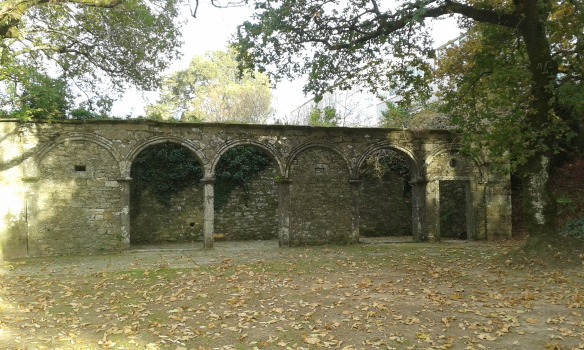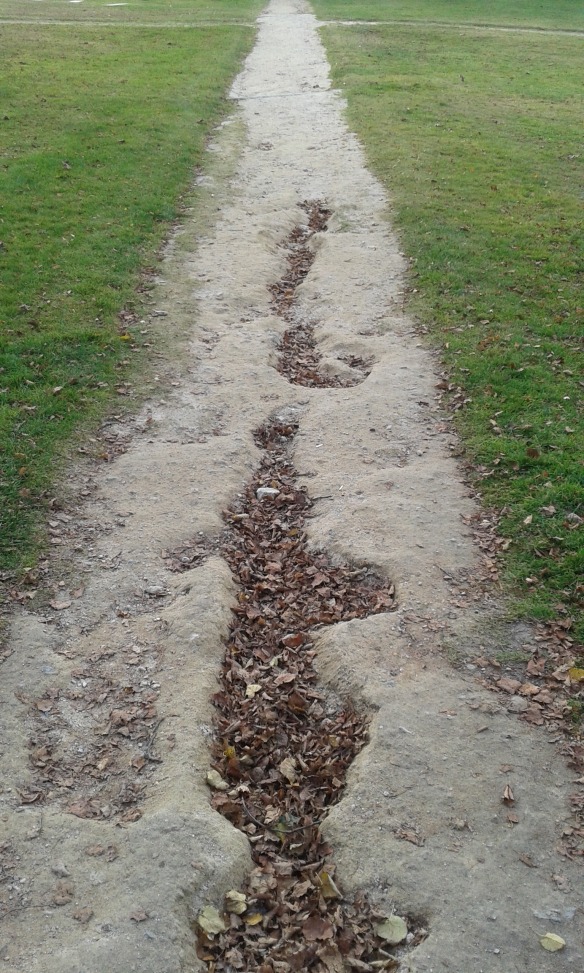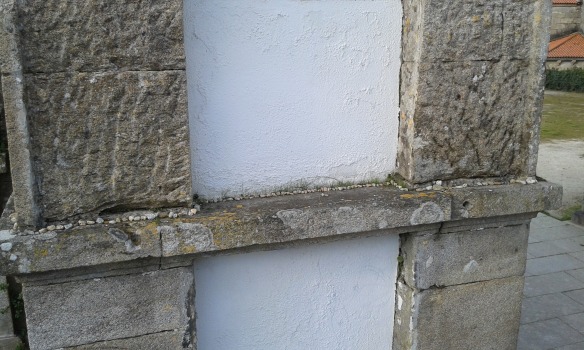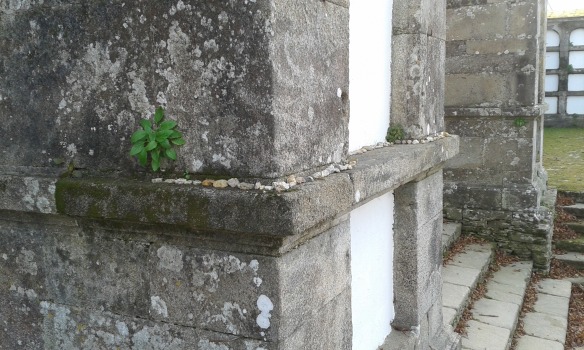A few weeks ago, I found myself traveling to Santiago De Compostela, Galicia. A journey along lines which hundreds of thousands of pilgrims before me will have made over the centuries. For most an act of faith, along the Way of St James, leading them to the great cathedral overlooking Praza do Obradoiro. Faced with limited time, my dilemma was, do I experience the ecclesiastical riches that this World Heritage Site has to offer or do I seek contemporary intersections between heritage, landscape and creativity.
Some cities reveal a creative pulse as you arrive on their outskirts, the first indications of life can often be tagging and stickers, as you travel further in you may encounter murals and other street art, which then blends and blurs with public art in the heart of the city. In the short time I had spent in Santiago De Compostela there was already enough signs of playful creativity…

 Thus I found myself outside the Centro Galego de Arte Contemporanea (CGAC) before it opened, and to fill a few minutes began to explore a park adjacent to it. I soon encountered a large piece by Basque Sculptor Eduardo Chillida, Porta da Música: it is said there is a peculiar sound when the wind blows against it !
Thus I found myself outside the Centro Galego de Arte Contemporanea (CGAC) before it opened, and to fill a few minutes began to explore a park adjacent to it. I soon encountered a large piece by Basque Sculptor Eduardo Chillida, Porta da Música: it is said there is a peculiar sound when the wind blows against it !
 Inevitably, I was drawn to the ruins of a building,
Inevitably, I was drawn to the ruins of a building,
 which appeared to be a wash house,
which appeared to be a wash house,
 and then I began to weave and flow up hill.
and then I began to weave and flow up hill.
Past another ruined building,
 the floor of which the stone slabs had been inscribed with numerous numbers.
the floor of which the stone slabs had been inscribed with numerous numbers.
 Whether these stones were an artistic intervention, interpretative device or integral to the work of Medieval numerologist was not revealed.
Whether these stones were an artistic intervention, interpretative device or integral to the work of Medieval numerologist was not revealed.
As I flowed further up, a succession of devices led the water down the hill,


 Until I encountered a stone cut hole
Until I encountered a stone cut hole
possible water cistern, grotto,
entrance to an underworld.
 So having flowed to the source, I was led downhill by a different path,
So having flowed to the source, I was led downhill by a different path,
autumn leaves nestled in dry flowing meanders.
 Leading to the remains of a contemporary stone circle, what ancient rites have taken place here?
Leading to the remains of a contemporary stone circle, what ancient rites have taken place here?
 But despite the joy of finding traces of contemporary prehistory,
But despite the joy of finding traces of contemporary prehistory,
moth-like I was drawn towards the walls of white beyond, to be immersed in a cemetery.
 I was looking so hard at what I was meant to see, the emptied recesses, names and numbers variously inscribed, that I nearly missed the continued flow of lines, no longer in water but this time a flow of stone.
I was looking so hard at what I was meant to see, the emptied recesses, names and numbers variously inscribed, that I nearly missed the continued flow of lines, no longer in water but this time a flow of stone.
These tiny traces, I first spotted adjacent to the entrance, and could follow, in one
 two
two
 three
three
 four compartments
four compartments
 Before they turned the corner.
Before they turned the corner.
 The stone then flowed along the length of another four tombs.
The stone then flowed along the length of another four tombs.
Occasional traces of embellishment punctuated the flow.
 And round the corner they continued.
And round the corner they continued.
 Meandering across another recess
Meandering across another recess
 and splashing to the other side.
and splashing to the other side.

 And then they stopped… was there no more….it made no sense, why only on this side…
And then they stopped… was there no more….it made no sense, why only on this side…
Eyes frantically danced across the compartments, and rested on a plume of feathers on the other side of the cemetery.

 And there the line was…
And there the line was…
And across the gap broken by steps,
 a sherd of brown glass, marked another point of departure.
a sherd of brown glass, marked another point of departure.
Meandering through another recess.
 Shells caught in the flow of stone.
Shells caught in the flow of stone.
 Round another corner it continued, then stone upon stone it flowed up the wall…
Round another corner it continued, then stone upon stone it flowed up the wall…
…beneath shiny marble progressed
 Further embellishment of feathers…
Further embellishment of feathers…
 And there, in the fourth compartment along the flow ceased….
And there, in the fourth compartment along the flow ceased….

Why do stones flow through the cemetery?
There is intent. There is an order of stones in the cemetery.
The stones are small, discretely positioned, but not hidden. In the higher, longer runs of stone, they have been placed at the very front edge of the compartments. Perhaps seeking to be spotted, yet precariously living on the edge. In contrast, the lower flows of stone which meander and splash across the gaps, hug the wall closely, nervous of being disturbed by passers.
The evident dislocation and obscuration of some stones by small plants, suggests they originally flowed some time earlier this year, it is clearly in a process of decay, but not totally ruinous. The traces of feather embellishment have a regularity, which suggests further feathers may have been placed to create an overall pattern or design.
We can imagine how it may have looked when first completed, resplendent ! But even in its full glory, how many have noticed the flow of stone within the cemetery.
We can only speculate as to who may have produced this, perhaps furtively, with no one else aware of their repeated visits to the cemetery: an individual act, contemplative, obsessive, beautiful in intent ?
Or was this created collectively as part of an art work, a publicly made installation ?
Widely known, much celebrated in the city,
and very occasionally revealed to the
flowing pilgrim.
————————————————————————————————————————
I flowed through the Parque de San Domingos de Bonaval. It was was the site of a 13th century convent, and after years of abandonment and neglect, was converted into a public space in 1995, about the process for which more details can be found here.
The core of the city is a World Heritage Site, Santiago de Compostela (Old Town), characterised by a rich ecclesiastical architectural and continued cultural heritage traditions of pilgrimage. There is also further World Heritage Site designations of locations associated with the pilgrimage routes, comprising Route of Santiago De Compostela and Routes of Santiago de Compostela in France.
 The poems were produced whilst walking urban waterways, the Dighty Burn in Dundee and the Denburn in Aberdeen. Like most now urban watercourses, they once offered ready route ways to the earliest travelers and often one of the reasons why towns and cities were founded where they were. Over the centuries, they have been variously modified and culverted, shaped and formed to serve the needs of urban life. Often becoming a focus of industry, providing power from watermills, and a convenient place to dispose of unwanted waste, historically having resulted in reduced water quality and biodiversity.
The poems were produced whilst walking urban waterways, the Dighty Burn in Dundee and the Denburn in Aberdeen. Like most now urban watercourses, they once offered ready route ways to the earliest travelers and often one of the reasons why towns and cities were founded where they were. Over the centuries, they have been variously modified and culverted, shaped and formed to serve the needs of urban life. Often becoming a focus of industry, providing power from watermills, and a convenient place to dispose of unwanted waste, historically having resulted in reduced water quality and biodiversity.
































